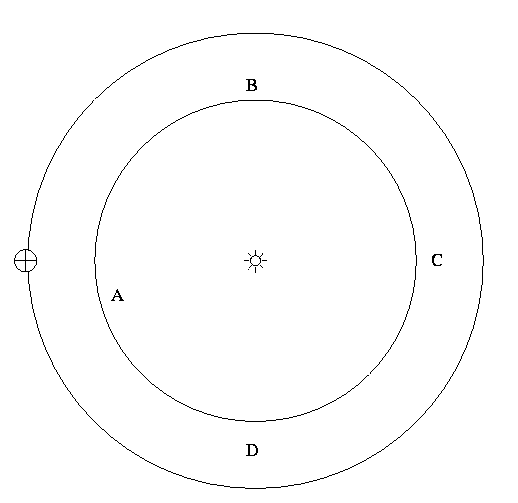 Copyright © Michael Richmond.
This work is licensed under a Creative Commons License.
Copyright © Michael Richmond.
This work is licensed under a Creative Commons License.
The Distance to and Size of Venus
Tonight you will determine the location of Venus in its orbit
around the Sun, the distance between the Earth and Venus,
and the planet's diameter.
Part I: Naked-eye observation
Your first task is to go outside, face the western horizon,
and make a sketch.
Your sketch should include the following features,
all drawn in their proper places:
- the western horizon
- Venus
- your best guess at the location of the sun below the horizon;
that is, its altitude (which will be negative) and its azimuth
- arrows showing North and South
Use your sketch to estimate the angular distance between Venus
and the Sun. You may use the rough rule that
a fist held at arm's length subtends about 10 degrees, or you
may devise some other means to measure angular distance.
Describe the method you use, and state clearly your estimate
of the angular distance in degrees.
Part II: Telescopic observations of Venus and Mizar
Each person in the class must perform the following steps and
create his own pictures; groups may average values determined
by all members if they wish.
Your next job requires a telescope. You must use the same telescope
and same eyepiece to make all observations, but you will
have a choice of several instruments.
There are two goals:
- to depict the shape of Venus
- to compare the angular sizes of Venus and the double star Mizar
Venus:
point the telescope at Venus and focus carefully.
Draw a picture of Venus, using the circular frame of the
picture to denote the edges of the field of view.
When you have finished, move the telescope gently
(using the handpaddle buttons for the Meade 10" in the dome,
or a very gentle push on the tube for others)
to the west.
Note the direction Venus moves in the eyepiece;
if the telescope moves West, then Venus will appear to slide
to the East.
Draw an arrow pointing West in your picture.
Fulfill all requests to look at Venus before moving
the telescope to Mizar.
Mizar:
Mizar is one of the bright stars in the handle of the
Big Dipper.
With your naked eye, you can see the star Alcor very close
to it.
If you look through a telescope,
you can see that Mizar itself is a double star.
As you look through the telescope, draw a picture which shows
the locations of Alcor and both of the components of Mizar
Part III: Analysis
-
Look in the Edmund Sky Guide to find the
distance between the two components of Mizar.
Figure out what fraction of the width of the field of view
was spanned by the two components.
What is the field of view, in arcseconds?
-
Now go back to your picture of Venus.
What fraction of the field of view does the planet subtend?
What is the diameter of Venus, in arcseconds?
Convert from arcseconds to degrees:
size in degrees = (size in arcseconds) / 3600
-
The shape of the lit portion of Venus depends on its position
relative to the Earth.
In the diagram below,
draw a picture which shows the appearance of Venus at points
A, B, C and D, as seen from the Earth.

-
Based on the appearance of Venus in your picture, indicate in the
diagram where Venus must be right now.
Explain your reasoning.
-
You measured the angle between the Sun and Venus earlier.
That angle appears in your diagram. Label it and give its size,
in degrees.
-
The Earth's orbit has a radius of R(Earth) = 150 million km.
Venus' orbit has a radius of about R(Venus) = 108 million km.
Use these values and your diagram to figure out the
distance between the Earth and Venus, right now.
- Using your value for the distance between the planets,
and the apparent angular size of Venus you determined
above, calculate the diameter of Venus in km.
Part IV: Evaluation
Use the SkyMap Pro program to check the
actual angular distance between Venus and the Sun,
and the actual angular size of Venus,
and the actual distance from the Earth to Venus.
Look up the actual diameter of Venus.
How close were your values?
Can you explain which step is responsible for most
of any error?
This page maintained by Michael Richmond.
Last modified Mar 9, 2002.
 Copyright © Michael Richmond.
This work is licensed under a Creative Commons License.
Copyright © Michael Richmond.
This work is licensed under a Creative Commons License.
 Copyright © Michael Richmond.
This work is licensed under a Creative Commons License.
Copyright © Michael Richmond.
This work is licensed under a Creative Commons License.
